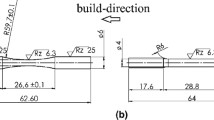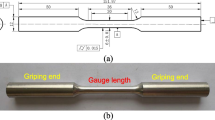Abstract
The present work unveils the features of heat dissipation and acoustic emission accompanying the fatigue crack growth in a titanium alloy (Ti-0.8Al-0.8Mn and Ti Grade 2) using the compact tension and Charpy V-notch specimens. The quantitative measurements of the heat dissipation rate were carried out by an original heat flux sensor. The obtained results reveal that there exist two appreciably different stages of the crack propagation within the stable Paris regime. Relationships between the crack growth rate and the heat dissipation rate are proposed for both stages. The application of the non-supervised clustering algorithm to the continuously recorded acoustic emission signal helped to identify two dominant mechanisms of stress relaxation that occur ahead of the crack tip—mechanical twinning and crack opening. The correlation between the acoustic emission energy and heat dissipation was found to be a harbinger of the approaching transition from stable to unstable crack growth.









Similar content being viewed by others
References
Iino, Y.: Fatigue crack propagation work coefficient – a material constant giving degree of resistance to fatigue crack growth. Eng. Fract. Mech. 12(2), 279–299 (1979). https://doi.org/10.1016/0013-7944(79)90120-6
Chow, C.L., Lu, T.J.: Cyclic J-integral in relation to fatigue crack initiation and propagation. Eng. Fract. Mech. 39(1), 1–20 (1991). https://doi.org/10.1016/0013-7944(91)90018-V
Dowling, N.E., Begley, J.A.: Mechanics of Crack Growth. ASTM STP 590, pp. 83–104. American Society for Testing and Materials, Philadelphia (1976)
Carpinteri, A., Montagnoli, F.: Scaling and fractality in subcritical fatigue crack growth: crack-size effects on Paris’ law and fatigue threshold. FFEMS. 43(4), 788–801 (2020). https://doi.org/10.1111/ffe.13184
Lindley, T.C., McCartney, L.N.: Mechanics and Mechanisms of Fatigue Crack Growth. Developments in Fracture Mechanics. Applied Science Publishers, London (1981)
Izumi, Y., Fine, M.E., Mura, T.: Energy considerations in fatigue crack propagation. Int. J. Fract. 17, 15–25 (1981). https://doi.org/10.1007/BF00043118
Chakrabarti, A.K.: En energy-balance approach to the problem of fatigue-crack growth. Eng. Fract. Mech. 10, 469–483 (1978). https://doi.org/10.1016/0013-7944(78)90058-9
Christensen, R.M., Wu, E.M.: A theory of crack growth in viscoelastic materials. Eng. Fract. Mech. 14, 215–225 (1981). https://doi.org/10.1016/0013-7944(81)90029-1
Bodner, S.R., Davidson, D.L., Lankford, J.: A description of fatigue crack growth in terms of plastic work. Eng. Fract. Mech. 17, 189–191 (1983). https://doi.org/10.1016/0013-7944(83)90169-8
Short, J.S., Hoeppner, D.W.: A global/local theory of fatigue crack propagation. Eng. Fract. Mech. 33(2), 175–184 (1989). https://doi.org/10.1016/0013-7944(89)90022-2
Memhard, D., Brocks, W., Frick, S.: Characterisation of ductile tearing resistance by energy dissipation rate. Fatigue Fract. Eng. Mater Struct. 16(10), 1109–1124 (1993). https://doi.org/10.1111/j.1460-2695.1993.tb00081.x
Turner, C.E., Koledni, O.: Application of energy dissipation rate arguments to stable crack growth. Fatigue Fract. Eng. Mater. Struct. 17(10), 1109–1127 (1994). https://doi.org/10.1111/j.1460-2695.1994.tb01402.x
Chudnovsky, A., Moet, A.: Thermodynamics of translational crack layer propagation. J. Mater. Sci. 20, 630–635 (1985). https://doi.org/10.1007/BF01026535
Strüwe, A., Pippan, R.: On the energy balance of fatigue crack growth. Comput. Struct. 44(1–2), 13–17 (1992). https://doi.org/10.1016/0045-7949(92)90218-O
Ivanova, V.S., Terentiev, V.F.: The Nature of the Fatigue of Metals. Metallurgy, Moscow (1975)
Troshchenko, V.T.: Deformation and Fracture of Metals Under High Cyclic Loading. Naukova Dumka, Kiev (1981)
Fedorov, V.V.: Thermodynamic Aspects of Strength and Fracture of Solids. FAN Uz SSR, Tashkent (1979)
Vshivkov, A.N., Iziumova, AYu., Panteleev, I.A., Ilinykh, A.V., Wildemann, V.E., Plekhov, O.A.: The study of a fatigue crack propagation in titanium grade 2 using analysis of energy dissipation and acoustic emission data. Eng. Fract. Mech. 210, 312–319 (2019). https://doi.org/10.1016/J.ENGFRACMECH.2018.05.012
Pascoe, J.A., Zarouchas, D.S., Alderliesten, R.C., Benedictus, R.: Using acoustic emission to understand fatigue crack growth within a single load cycle. Eng. Fract. Mech. 194, 281–300 (2018). https://doi.org/10.1016/j.engfracmech.2018.03.012
Chai, M., Zhang, J., Zhang, Z., Duan, Q., Cheng, G.: Acoustic emission studies for characterisation of fatigue crack growth in 316LN stainless steel and welds. Appl. Acoust. 126, 101–113 (2017). https://doi.org/10.1016/j.apacoust.2017.05.014
Botvina, L.R., Soldatenkov, A.P., Tyutin, M.R., Demina, YuA, Levin, V.P., Petersen, T.B.: On interrelation of damage accumulation in structural steels and physical parameters estimated by methods of acoustic emission and metal magnetic memory. Russ. Metall. 2017, 10–17 (2017). https://doi.org/10.1134/S0036029517010037
Botvina, L.R., Oparina, I.B., Shebalin, P.N.: A mechanism of temporal variation of seismicity and acoustic emission prior to macrofailure. Dokl. Phys. 46(2), 119–123 (2001). https://doi.org/10.1134/1.1355388
Botvina, L.R., Soldatenkov, A.P., Levin, V.P., Tyutin, M.R., Demina, Y.A., Petersen, T.B., Dubov, A.A., Semashko, N.A.: Assessment of mild steel damage characteristics by physical methods. Russ. Metall. 2016(1), 23–33 (2016). https://doi.org/10.1134/S0036029516010067
Carpinteri, A., Lacidogna, G., Corrado, M., Di Battista, E.: Cracking and crackling in concrete-like materials: a dynamic energy balance. Eng. Fract. Mech. 155, 130–144 (2016). https://doi.org/10.1016/j.engfracmech.2016.01.013
Sato, Y., Kawaguchi, N., Ogura, N., Kitayama, T.: Automated visualisation of surface morphology of cracks by means of induced current potential drop technique. NDT&E Int. 49, 83–89 (2012). https://doi.org/10.1016/j.ndteint.2012.04.005
Nayeb-Hashemi, H., Swet, D., Vaziri, A.: New electrical potential method for measuring crack growth in nonconductive materials. Measurement 36, 121–129 (2004). https://doi.org/10.1016/j.measurement.2004.05.002
Hartman, G.A., Johnson, D.A.: D-C electric-potential method applied to thermal/mechanical fatigue crack growth. Exp. Mech. 27, 106–112 (1987). https://doi.org/10.1007/BF02318872
Vshivkov, A., Iziumova, A., Bär, U., Plekhov, O.: Experimental study of heat dissipation at the crack tip during fatigue crack propagation. Frattura ed Integrità Strutturale. 35, 131–137 (2016). https://doi.org/10.3221/IGF-ESIS.35.07
Pomponi, E., Vinogradov, A.: A real-time approach to acoustic emission clustering. Mech. Syst. Signal Process. 2, 791–804 (2013). https://doi.org/10.1016/j.ymssp.2013.03.017
Ranganathan, N., Chalon, F., Meo, S.: Some aspects of the energy based approach to fatigue crack propagation. Int. J. Fatigue 30, 1921–1929 (2008). https://doi.org/10.1016/j.ijfatigue.2008.01.010
Vinogradov, A., Vasilev, E., Linderov, M., Merson, D.: In situ observations of the kinetics of twinning–detwinning and dislocation slip in magnesium. Mater. Sci. Eng. A 676, 351–360 (2016). https://doi.org/10.1016/j.msea.2016.09.004
Danyuk, A., Rastegaev, I., Pomponi, E., Linderov, M., Merson, D., Vinogradov, A.: Improving of acoustic emission signal detection for fatigue fracture monitoring. Procedia Eng. 176, 284–290 (2017). https://doi.org/10.1016/j.proeng.2017.02.323
Vinogradov, A., Yasnikov, I.S.: On the nature of acoustic emission and internal friction during cyclic deformation of metals. Acta Mater. 70, 8–18 (2014). https://doi.org/10.1016/j.actamat.2014.02.007
Acknowledgements
The reported study was funded by RFBR, project number 20-31-70018.
Author information
Authors and Affiliations
Corresponding author
Ethics declarations
Conflict of interest
The authors declare that they have no conflict of interest.
Additional information
Publisher's Note
Springer Nature remains neutral with regard to jurisdictional claims in published maps and institutional affiliations.
Rights and permissions
About this article
Cite this article
Iziumova, A.Y., Vshivkov, A.N., Prokhorov, A.E. et al. Heat dissipation and acoustic emission features of titanium alloys in cyclic deformation mode. Acta Mech 232, 1853–1861 (2021). https://doi.org/10.1007/s00707-020-02911-4
Received:
Revised:
Accepted:
Published:
Issue Date:
DOI: https://doi.org/10.1007/s00707-020-02911-4




